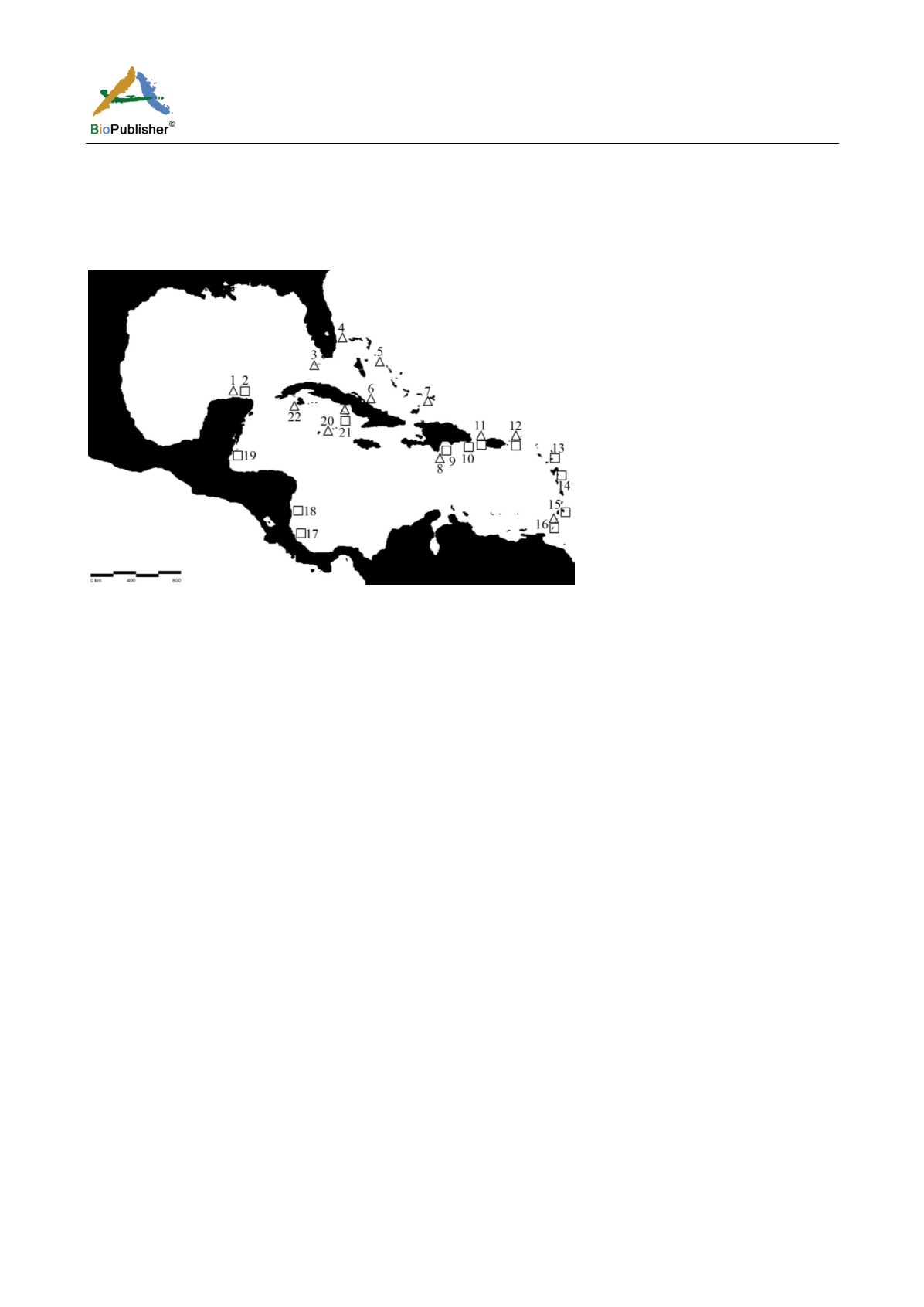
International Journal of Marine Science, 2017, Vol.7, No.33, 316-343
328
sampling. These MSAs were named ―MSA according to our approach‖ (MSAoa). In addition, for each maturation
category and sequence length, one MSA was executed in which the haplotype frequencies of each source and
aggregation were temporarily grouped, using the most actualized Nr (decade of 2000) in consideration of the
criteria most commonly used in the literature (Supplementary Material 4; Supplementary Material 5). This MSA,
declared as "MSA grouped" (MSAgr), was compared with the MSAoa.
Figure 5 Aggregations (triangle) and rookeries (square) used in the MSAs of the present study
Note: 1: Rio Lagartos (RL), Yucatan, Mexico; 2: Las Coloradas (ME), Yucatan, Mexico; 3: Key West National Wildlife Refuge
(FKW), Florida, USA; 4: Palm Beach County (FPB), Florida, USA; 5: Bahamas (BA); 6: Jardines del Rey (JR), Cuba; 7: Turks and
Caicos (TnC); 8: south of Dominican Republic (Do); 9: Jaragua National Park (DoJ), Dominican Republic; 10: Saona Island (DoS),
Dominican Republic; 11: Mona Island (MI), Puerto Rico; 12: Buck Island (USVI), United States Virgin Islands; 13: Jumby Bay
(ANT), Antigua; 14: Trois Ilets (GU), Guadeloupe; 15: Barbados leeward (BaL) and windward (BaW) coasts; 16: Tobago leeward
(ToL) and windward (ToW) coasts; 17: Tortuguero (CR), Costa Rica; 18: Pearl Cays (NI), Nicaragua; 19: Gales Point (BE), Belize;
20: Bloody Bay and west of Grand Cayman (CI), Cayman Islands; 21: Doce Leguas (DL), Cuba; 22: Cocodrilo (IJ), Isla de la
Juventud, Cuba
Although the monthly frequency of harvested
E. imbricata
individuals in the JR fishing ground did not vary
significantly between the years according to sexual and SCL classes (Lee-González et al., 2015), we found an
inversion of the frequency of the haplotypes EiA01 and EiA11 for non-adult individuals between 2004 and 2005.
Thus, we consider it appropriate to analyze each year as an independent non-adult fishing aggregation. As JR did
not have a representative sample in 2006 for any maturation category, this year was grouped with 2004 and 2005
in the JR adult aggregation.
We could segregate all Cuban fishing aggregations from the 1990s in both maturation categories because we had
access to the original data of Díaz-Fernández (1999). All individuals from the aggregations of that study having
CU1 and PR1 were regarded EiA01 and EiA11 respectively. We use the original name for Cuba A (Doce Leguas)
and Cuba B (Cocodrilo) fishing aggregations. For non-adult aggregations from Mona Island of the 1990s we only
selected the sample of Díaz-Fernández (1999) because of its larger sample size as compared to other 1990s studies
(Bowen et al., 1996; Bass, 1999) and its haplotype frequency did not present significant statistical differences. The
haplotypes absent in the selected samples of JR and Mona Island aggregations but belonging to other temporal
samplings were also included. The foraging aggregation of new recruits from the Mona Island platform from
Velez-Zuazo et al. (2008) was excluded from the MSAs because we considered this is a very premature non-adult
stage having smaller SCLs than the remaining WC non-adult foraging aggregations.
3.3.2 Rookeries
Genetic data from WC rookeries were used to calculate WC source contributions to the JR fishing ground
(foraging ground-centric), or the proportions of individuals in each rookery in JR (rookery-centric).


